
Introduction
The gaming monitor market has grown a lot over the
last couple of years, with new players like Asus and Acer making a big impact
and offering a great range of innovative displays and technologies. Some of the
more mainstream manufacturers like Dell, NEC, HP and Eizo have stayed away from
this market on the most part and focused on more general uses and their
professional grade screens. Dell recently entered the gaming market with
their
S2716DG, a 27" 1440p TN Film screen with 1ms response time, 144Hz refresh
rate and support for NVIDIA G-sync and blur reduction amongst other things. Eizo
very rarely venture into the gaming market either, but if we think back to late
2013 we were impressed by the performance and innovation of their 23.5"
Foris FG2421 display. Amongst all the noise from Acer and Asus in the gaming
market, and with the arrival of G-sync/FreeSync from the major graphics card
vendors, Eizo are now releasing their new Foris FS2735 display. This offers an
impressive spec with a 27" 1440p IPS-type panel, 144Hz refresh rate, AMD
FreeSync support and an additional blur reduction mode. They have also added all
kinds of fancy features including mobile phone integration and control for
instance. There's been quite a few high refresh IPS panels launched now, but
this is the first from Eizo which carries with it promises of quality,
reliability and support which many people have been waiting for. We've got the
Foris FS2735 with us now for review ahead of its full launch.
If you appreciate the review
and enjoy reading and like our work, we would welcome a
donation
to the site to help us continue to make quality and detailed reviews for you.

Specifications and Features
The following table gives detailed information
about the specs of the screen:
|
Monitor
Specifications |
|
Size |
27"WS (68.5 cm) |
Panel Coating |
Light AG coating |
|
Aspect Ratio |
16:9 |
Interfaces |
1x DisplayPort 1.2a
2x HDMI 1.4
1x DVI
|
|
Resolution |
2560 x 1440 |
|
Pixel Pitch |
0.233 mm |
Design
colour |
Matte black bezel and stand |
|
Response Time |
4ms G2G |
Ergonomics |
Tilt, height, rotate, swivel |
|
Static Contrast Ratio |
1000:1 |
|
Dynamic Contrast Ratio |
n/a |
VESA Compatible |
Yes 100mm |
|
Brightness |
350 cd/m2 |
Accessories |
Power, DisplayPort and USB cables |
|
Viewing Angles |
178/ 178 |
|
Panel Technology |
AU Optronics AHVA (IPS-type) |
Weight |
boxed: 10.1Kg |
|
Backlight Technology |
W-LED |
Physical Dimensions |
(WxHxD) with stand:
618.8 x 393.7 - 548.7 x 197.9 mm |
|
Colour Depth |
16.7m (8-bit) |
|
Refresh Rate |
144Hz native
FreeSync range 56 - 144Hz
or 35 - 90Hz |
Special
Features |
2x
USB 3.0 ports, 2x 1W stereo speakers, audio out, headphone port, AMD
FreeSync, Blur Reduction mode, Auto EcoView ambient light sensor |
|
Colour Gamut |
Standard gamut
~sRGB, ~72% NTSC |
The FS2735 offers a good range of connectivity
options given the use of AMD FreeSync, which is not limited in the same way that
NVIDIA G-sync modules currently are. This model offers DP 1.2a, DVI and 2x HDMI 1.4 inputs
so you can connect multiple devices including games consoles. The digital
interfaces are HDCP certified for encrypted content and the video cables are
provided in the box for DisplayPort only.
The screen has an internal power supply with the power cable you need
in the box. There are also 2x USB 3.0 ports,
located for easy-access on the left hand side at the back (cable provided in the
box). There are also audio
out and headphone ports offered along with 2x 1W integrated stereo speakers for
basic sound. Eizo have also provided their EcoView ambient light sensor feature which
is useful.
Below is a summary of the features and connections
of the screen:
|
Feature |
Yes / No |
Feature |
Yes / No |
|
Tilt adjust |
 |
DVI |
 |
|
Height adjust |
 |
HDMI |
 |
|
Swivel adjust |
 |
D-sub |
 |
|
Rotate adjust |
 |
DisplayPort |
 |
|
VESA compliant |
 |
Component |
 |
|
USB 2.0 Ports |
 |
Composite |
 |
|
USB 3.0 Ports |
 |
Audio connection |
 |
|
Card Reader |
 |
HDCP Support |
 |
|
Ambient Light Sensor |
 |
MHL Support |
 |
|
Human Motion Sensor |
 |
Integrated Speakers |
 |
|
Touch Screen |
 |
PiP / PbP |
 |
|
Factory Calibration |
 |
Blur Reduction Mode |
 |
|
Hardware calibration |
 |
G-Sync |
 |
|
Uniformity correction |
 |
FreeSync |
 |

Design and Ergonomics

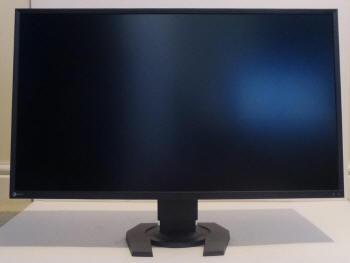
Above: front view of the screen. Click for larger versions
The FS2735 comes in a fairly minimalist all
black design, with a thin bezel and matte plastics used throughout. The
bezel is a very thin 10mm around the sides and top, and only 14mm thick
along the bottom edge as well. There's a small Eizo logo in the bottom
left hand corner but no other writing or labels on the front.
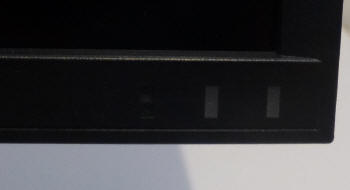
Above: power
LED and ambient light sensor. Click for larger version
The bottom right hand corner has a fairly
small power LED (right most rectangle here) which glows white during
normal operation, red when FreeSync is enabled and amber when the screen
is in standby. Next to this is another indicator although we've not
extensively tested every option and setting so not sure when they lights
up to be honest. There is then the EcoView ambient light sensor on the
left (hard to see in the photo as it's very subtle).
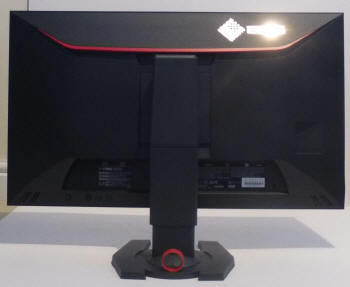
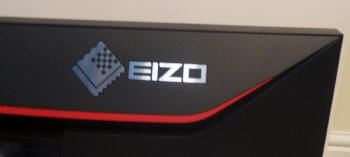
Above: rear
views of the screen. Click for larger versions
The back of the screen provides some red
coloured contrast sections which make the screen stand out. There's also a
shiny Eizo logo in the top right hand area. There's actually a ridge
beneath the red trim at the top which allows you to carry the screen
easily. The back of the screen is again a matte black plastic. The stand
attaches in the middle at the back and there is a quick release button if
you want to remove it and arm- / wall-mount the screen, or transport it.
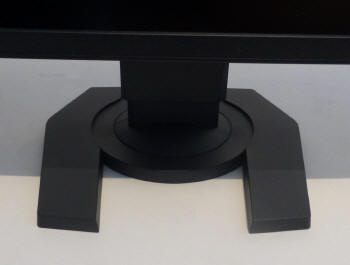
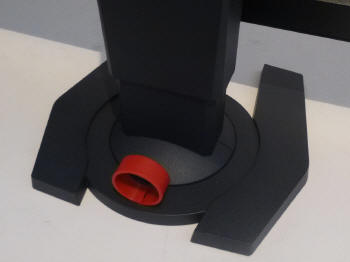
Above:
views of the base and able tidy. Click for larger versions
The stand is again fairly minimalist but
provides a sturdy enough base for the screen. There is a detachable cable
tidy clip on the back in red as you can see above.

The FS2735 provides a decent range of
ergonomic adjustments with tilt, height and rotate offered. Swivel side to
side is not available although the screen is light enough and with a small
enough foot-print that you can easily move it from side to side if you
want.
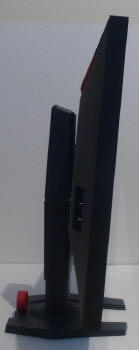
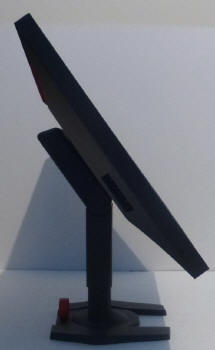
Above: full
tilt range shown. Click for larger versions
The side profile of the screen itself is
fairly thin, thanks to the use of W-LED backlighting. There is a good tilt
range available as shown above, although its very stiff to move. The stand
bends part way down as you can see above which is why it feels stiff.
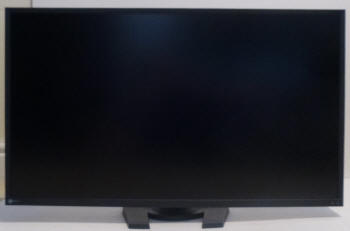
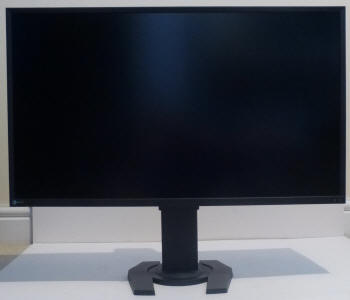
Above: full
height adjustment range shown, click for larger versions
The height adjustment is again stiff to
operate but does provide smooth movement. You do have to force it quite a
lot to re-position it though, as you do with the tilt. At its lowest setting
the bottom edge of the display is 30mm from the desk surface, and once
extended to maximum height it is 185mm. This gives a total 155mm
adjustment range. Rotation in to portrait mode is equally stiff again, but
at least provided if you want it.
A summary of the screens ergonomic adjustments
is shown below:
|
Function |
Range |
Smoothness |
Ease of Use |
|
Tilt |
Yes |
Smooth |
Very stiff |
|
Height |
155mm |
Smooth |
Stiff |
|
Swivel |
No |
- |
- |
|
Rotate |
Yes |
Moderate |
Stiff |
|
Overall |
Good range of adjustments
offered, but all very stiff really to operate. |
The materials were of a good standard and the
build quality felt very good as well. We liked the ultra-thin bezel design as
well. There was a
very slight audible whine from the screen, but only if you listened very
closely to it. Certainly nothing you could detect in normal use from a normal
distance. The screen also remains cool even during prolonged use. One thing
to note is that we occasionally had troubles with the screen resuming from
sleep if the PC had been sleeping. When the monitor goes to sleep on its own
with PC still on, it wakes up fine. However if the PC comes out of sleep
sometimes the screen doesn't wake up properly. Fortunately you can fix this
with a quick off/on of the screen via the power button.


Above:
interface connections on the back of the screen
The back of the screen provides the video
connections as shown above. There are audio out, headphone jack, 2x HDMI, DVI
and DisplayPort 1.2a and USB upstream connections provided on this model.
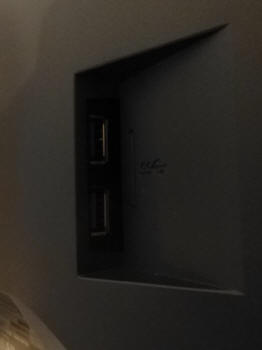
Above: 2x USB
3.0 ports on the left hand back area
On the left hand back area of the screen are two
relatively easy access USB 3.0 ports. Useful to have these more readily
available in this location we thought, and not on the underside with the video
connections.

OSD Menu
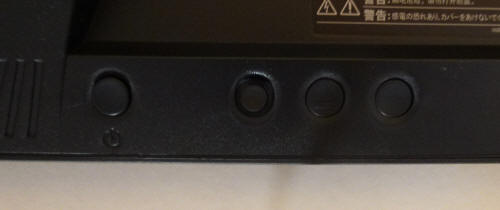
Above: OSD control buttons on the bottom edge of the screen. Click for
larger version
The OSD menu is accessed and controlled through 2
pressable buttons and one joystick located on the back of the screen on the right hand
area. There is also a power on/off button. Due to the location of the buttons,
it's not always obvious which one you are pressing and there are no markings on
the front of the screen to guide you, although it's easy enough to
find the joystick which controls most of the functions anyway.
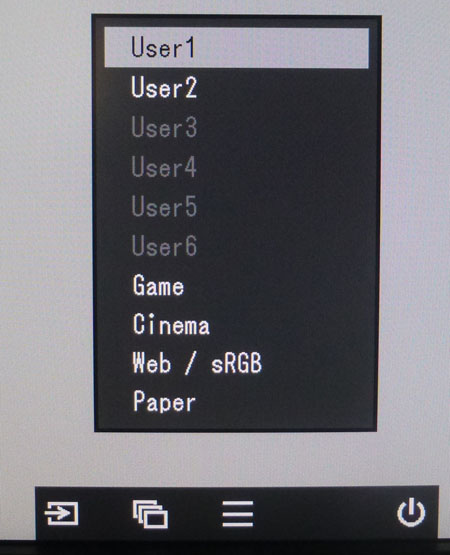
Pressing any of the buttons or moving the joystick
brings up the quick launch icons at the bottom of the screen as shown above
(bottom of the photo),
telling you what each button will then do, and giving you an idea of where they
are located round at the back of the screen. You can quickly switch between
inputs and the preset modes (shown above) with the two buttons. If you move the
joystick left or right you can quickly change the brightness setting, and moving
it up down you can change the volume. Pressing the joystick in like a button brings up the
main OSD menu:
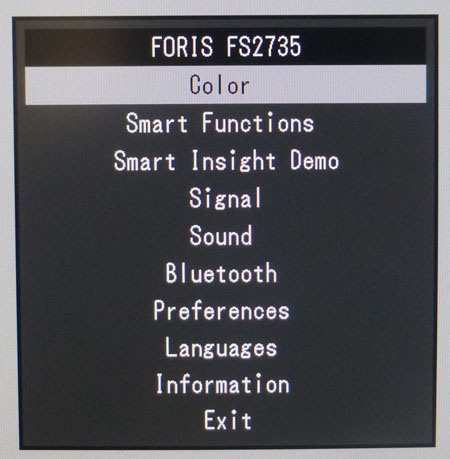
The main menu is split in to 9 sections with
plenty of options to play with. We won't go through everything here as it would
take too long and you can refer to the user manual for more information.
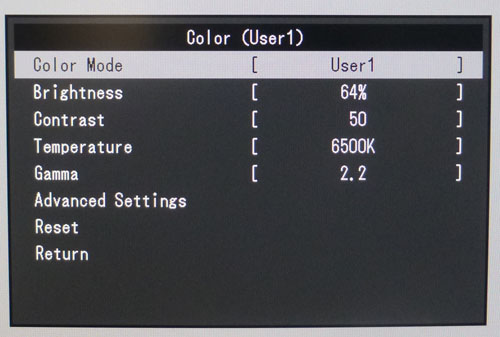
The first "color" menu contains most of the
options you will want to change including the preset modes, brightness, colour
temp, gamma mode etc. You can also access the "advanced settings" section:
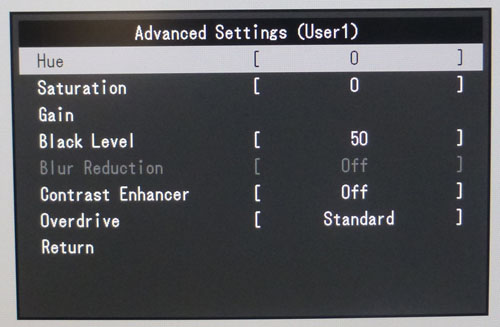
This section allows you to control some other
useful features including the
overdrive control and
blur reduction mode which we
will test later on.
All in all the menu was responsive and easy
and intuitive to navigate thanks to the joystick. The location of the buttons
was a bit fiddly though and not as easy to use as some other screens and
sometimes we found ourselves turning the screen off accidentally. Getting
in to some of the menu sections too quite a few presses as well but overall it
was decent enough and certainly plenty of options to play with. We did like
all the user configurable preset modes as well.

Panel and Backlighting
|
Panel Manufacturer |
AU Optronics |
Colour Palette |
16.7 million |
|
Panel Technology |
AHVA (IPS-type) |
Colour Depth |
8-bit |
|
Panel Module |
M270DAN02.3 |
Colour space |
Standard gamut |
|
Backlighting Type |
W-LED |
Colour space coverage (%) |
~sRGB, ~72% NTSC |
Panel Part and Colour Depth
The Eizo Foris FS2735 features an
AU Optronics M270DAN02.3 AHVA (IPS-type) panel which is capable of producing
16.78 million colours. The panel offers an 8-bit colour depth and the part is
confirmed when dismantling the screen as shown below and is the exact same as
that used in the
Acer Predator XB270HU and
Asus MG279Q with great success already.
We want to try and ensure
there's no confusion between AHVA and IPS as well at this juncture. AHVA
(Advanced Hyper Viewing Angle) is a relatively new technology developed by AU
Optronics, not to be confused with their more long-standing technology AMVA
(Advanced Multi-Domain Vertical Alignment). It is AU Optronics' answer to
LG.Display's very popular, and long-established IPS (In Plane Switching)
technology. Testing of this technology has revealed that it is for all intents
and purposes the same as IPS. Performance characteristics, features and specs
are all pretty much identical. AUO weren't allowed to simply call their
technology IPS due to trademark issues, which is why they adopted their own new
name. Samsung are the same with their PLS (Plane to Line Switching) panel tech,
which is another IPS-clone. You will see pretty much all monitor manufacturers
now simply use the term IPS, since it is so well known in the market, but
underneath they may be using an IPS version from LG.Display, AU Optronics or
Samsung potentially. People should not get concerned with the semantics here,
which is why we will continually refer to this as an "IPS-type" panel throughout
the review.
The part is confirmed when dismantling the screen:
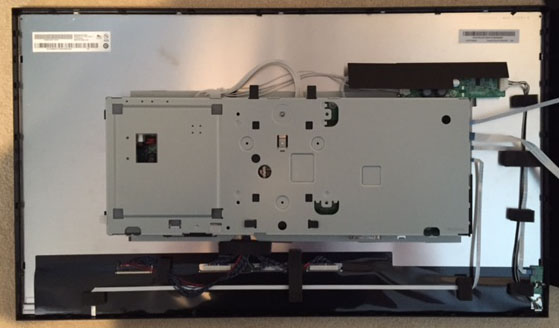
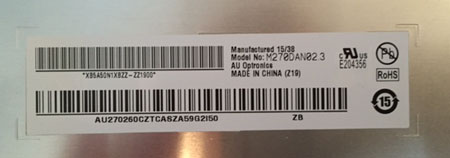
Screen
Coating
The
screen coating is a light anti-glare (AG) offering. It isn't a semi-glossy
coating, but it is light as seen on other modern IPS type panels. Thankfully it
isn't a heavily grainy coating like some old IPS panels feature and is also
lighter than modern TN Film panel coating. It retains its anti-glare properties
to avoid too many unwanted reflections of a full glossy coating, but does not
produce an too grainy or dirty an image that some thicker AG coatings can. There
were some very slight cross-hatching patterns visible on the coating if you
looked very closely, but nothing to the extent of what some people find
problematic on the U2713HM model.
Backlight Type and Colour Gamut
The screen uses a White-LED (W-LED) backlight unit
which is standard in today's market. This helps reduce power
consumption compared with older CCFL backlight units and brings about some
environmental benefits as well. The W-LED unit offers a standard colour gamut
which is approximately equal to the sRGB colour space.
Anyone wanting to work with wider colour spaces would need to consider wide
gamut CCFL screens or the newer range of GB-r-LED type (and similar) displays available
now. If
you want to read more about colour spaces and gamut then please have a read of
our
detailed article.
Backlight
Dimming and Flicker
We tested the screen to establish the methods used
to control backlight dimming. Our in depth article talks in more details about a
common method used for this which is called
Pulse Width Modulation (PWM). This in itself gives cause for concern to some
users who have experienced eye strain, headaches and other symptoms as a result
of the flickering backlight caused by this technology. We use a photosensor +
oscilloscope system to measure backlight dimming control
with a high level of accuracy and ease. These tests allow us to establish
1) Whether PWM is being used to control the
backlight
2) The frequency and other characteristics at which this operates, if it is used
3) Whether a flicker may be introduced or potentially noticeable at certain
settings
If PWM is used for backlight dimming, the higher
the frequency, the less likely you are to see artefacts and flicker. The duty
cycle (the time for which the backlight is on) is also important and the shorter
the duty cycle, the more potential there is that you may see flicker. The other
factor which can influence flicker is the amplitude of the PWM, measuring the
difference in brightness output between the 'on' and 'off' states. Please
remember that not every user would notice a flicker from a backlight using PWM,
but it is something to be wary of. It is also a hard thing to quantify as it is
very subjective when talking about whether a user may or may not experience the
side effects.
100%
50%


scale = 1
horizontal grid = 5ms
20% (zoomed in)
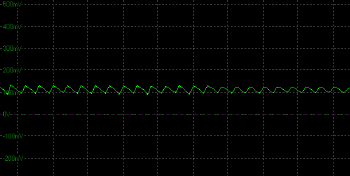
At 100% brightness a constant voltage is applied
to the backlight. As you reduce the brightness setting to dim the backlight a
Direct Current (DC) method is used for a considerable range, down to a setting
of around 55%. From 55% and below an oscillation is introduced but it operates
at a very high frequency of 2000Hz and with a very low amplitude as well. This
shouldn't present any problems for the majority of users since it's in no way a
full PWM operation.
|
Pulse Width
Modulation Used |
Hybrid |
|
Cycling
Frequency |
100 - 56% = n/a
55 - 0% = 2000Hz low amplitude oscillation only |
|
Possible
Flicker at |
|
|
100% Brightness |
No |
|
50% Brightness |
Unlikely |
|
0% Brightness |
Unlikely |
For an up to date list of all flicker-free (PWM free) monitors please see our
Flicker Free Monitor Database.

Contrast
Stability and Brightness
We wanted to see how much variance there was in
the screens contrast as we adjusted the monitor setting for brightness.
In theory, brightness and contrast are two independent parameters, and good
contrast is a requirement regardless of the brightness adjustment.
Unfortunately, such is not always the case in practice. We recorded the
screens luminance and black depth at various OSD brightness settings, and
calculated the contrast ratio from there. Graphics card settings were left at
default with no ICC profile or calibration active. Tests were made using an
X-rite i1 Display Pro colorimeter. It should be noted that we used the
BasICColor calibration software here to record these, and so luminance at
default settings may vary a little from the LaCie Blue Eye Pro report.
|
OSD
Brightness |
Luminance
(cd/m2) |
Black
Point (cd/m2) |
Contrast
Ratio
( x:1) |
|
100 |
331.10 |
0.33 |
1003 |
|
90 |
238.83 |
0.24 |
995 |
|
80 |
162.27 |
0.16 |
1014 |
|
70 |
114.30 |
0.12 |
952 |
|
60 |
73.64 |
0.07 |
1052 |
|
50 |
47.97 |
0.05 |
959 |
|
40 |
28.22 |
0.03 |
941 |
|
30 |
16.71 |
<0.02 |
- |
|
20 |
8.60 |
<0.02 |
- |
|
10 |
3.96 |
<0.02 |
- |
|
0 |
1.17 |
<0.02 |
- |
|
Total Luminance Adjustment Range
(cd/m2) |
329.93 |
Brightness OSD setting controls backlight? |
 |
|
Total Black Point
Adjustment Range (cd/m2) |
>0.31 |
|
Average Static Contrast Ratio |
988:1 |
PWM Free? |
Hybrid |
|
Recommended OSD setting
for 120 cd/m2 |
71 |
The brightness control gave us a very good range
of adjustment. At the top end the maximum luminance reached 331
cd/m2 which was
only a little shy of the specified maximum brightness of 350 cd/m2
from the manufacturer. There was a very impressive 330 cd/m2
adjustment range in total, and so at the minimum setting you could reach down to
an incredibly low luminance of only 1 cd/m2. This should of course be adequate for those
wanting to work in darkened room conditions with low ambient light and Eizo have
focused on offering a full adjustment range for the backlight, particularly
accommodating users at the lower end of the brightness range. In fact, you need
a setting of 71 in the OSD menu should return you a
luminance of around 120 cd/m2 at default settings. At the higher
brightness setting end, small changes make quite significant changes to the
luminance output and actually we would have preferred a little more control
within the 80 - 200 cd/m2 kind of range than we had. Does anyone
really need to use the screen below around 50 cd/m2,
Let alone at the crazy low settings you can get down to here? With the 50%
brightness setting returning a luminance of 48
cd/m2
we felt we would have
preferred that to have been achieved when you were at a lower brightness setting
really.
It should be noted that the
brightness regulation is controlled without the need for
Pulse Width Modulation, using a Direct Current (DC) method for brightness settings between 100 and
55%. From 55% and below a low amplitude and high frequency (2000Hz) oscillation
is introduced, although it's not likely to cause any problems for users. Even
so, you can reach down to a very low luminance which will be adequate for most
users anyway without any kind of oscillation introduced given where it kicks in.

We have plotted the
luminance trend on the graph above. The screen behaves as it should in this
regard, with a reduction in the luminance output of the screen controlled by the
reduction in the OSD brightness setting. This is not a linear relationship as
you can see, with settings between 100 and 60% controlling a very steep
adjustment curve, before lower settings give you more finite control over the
luminance output.
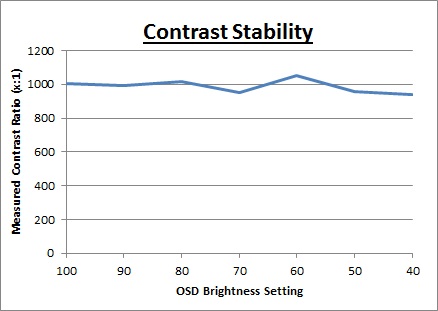
The average contrast ratio of
the screen was good for an IPS-type panel with an average of 9881. This was
mostly stable across the brightness adjustment range as shown above. We've cut
out the measurements for below 40% brightness as the screen was so dark that a
black measurement was below the 0.02
cd/m2
lower limit threshold of the
X-rite i1 Display Pro measurement device.

Testing
Methodology
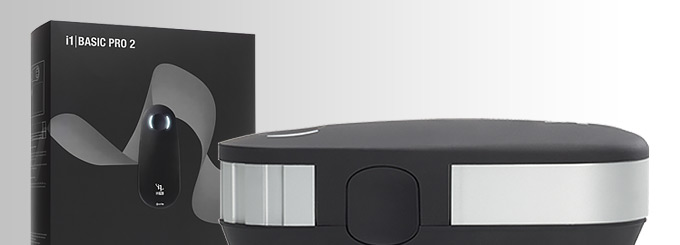
An
important thing to consider for most users is how a screen will perform out of
the box and with some basic manual adjustments. Since most users won't have
access to hardware colorimeter tools, it is important to understand how the
screen is going to perform in terms of colour accuracy for the average user.
We restored our graphics card to default settings
and disabled any previously active ICC profiles and gamma corrections. The
screen was tested at default factory settings using our new
X-rite i1
Pro 2 Spectrophotometer combined with
LaCie's Blue Eye Pro software suite. An X-rite i1 Display Pro colorimeter was
also used to verify the black point and contrast ratio since the i1 Pro 2
spectrophotometer is less
reliable at the darker end.
Targets for these tests are as follows:
-
CIE Diagram - validates the colour space
covered by the monitors backlighting in a 2D view, with the black triangle representing the
displays gamut, and other reference colour spaces shown for comparison
-
Gamma - we aim for 2.2 which is the default
for computer monitors
-
Colour temperature / white point - we aim
for 6500k which is the temperature of daylight
-
Luminance - we aim for 120
cd/m2, which is
the recommended luminance for LCD monitors in normal lighting conditions
-
Black depth - we aim
for as low as possible to maximise shadow detail and to offer us the best
contrast ratio
-
Contrast ratio - we aim
for as high as possible. Any dynamic contrast ratio controls are turned off here
if present
-
dE average / maximum -
as low as possible.
If DeltaE >3, the color displayed is significantly different from the
theoretical one, meaning that the difference will be perceptible to the
viewer.
If DeltaE <2, LaCie considers the calibration a success; there remains a
slight difference, but it is barely undetectable.
If DeltaE < 1, the color fidelity is excellent.

Default Performance and
Setup
Default settings of the screen were as follows:
|
Monitor OSD Option |
Default Settings |
|
Preset mode |
User1 |
|
Brightness |
90 |
|
Contrast |
50 |
|
RGB |
98, 100, 95 |
|
Temperature |
6500k |
|
Gamma |
2.2 |

Eizo Foris FS2735 - Default Settings





|
|
Default Settings |
|
luminance (cd/m2) |
246 |
|
Black Point (cd/m2) |
0.25 |
|
Contrast Ratio |
995:1 |
Although this IPS-type panel is not exclusive to the
Foris FS2735, Eizo has according to their product team taken extra
steps to ensure
the accuracy of the colour display. It is produced in the same factory at Eizo
headquarters in Japan
as their medical monitors and graphics monitors. The colour temperature, gamma,
white balance,
and brightness of each FS2735 unit is individually checked and adjusted by a
camera in the factory apparently. In the final
phase of production, each unit is inspected by the human eye to ensure mid-tones
and hues are displayed properly also. So while there is no specific factory
calibration report provided in the box or anything, they should be calibrated
nicely out of the box it seems. We went ahead and tested it.
Initially out of the box the screen was set in the
default 'user1' preset. You could tell the screen was using a
standard gamut backlight and the image looked reasonably good to the naked eye, but
certainly too bright for
comfortable use. If Eizo are checking the brightness in the factory, they are
obviously checking to some high level requirement! Colour balance felt pretty good, but maybe slightly too warm. We went ahead and measured the default state with
the i1 Pro 2.
The
CIE diagram on the left of the image confirms that the monitors colour gamut
(black triangle) is roughly equal to the sRGB colour space. There is some minor
over-coverage in all shades but not by anything significant at all. Gamma was
well set up with 2.2 average measured (0% deviance) which was pleasing and shows
a reliable factory calibration. The
white point was a little off, being slightly too warm at 6096k (404k out / 6%
deviance).
Luminance was recorded at a very bright 246
cd/m2 which is
too high for prolonged general use. The screen was set at a default 90%
brightness in the OSD menu but that is easy to change of course to reach a more
comfortable setting without impacting any other aspect of the setup. The black
depth was 0.25 cd/m2 at this default
brightness setting, giving us a very good static contrast ratio (for an IPS-type panel) of
995:1.
Colour accuracy was ok on the most part although
blue shades appeared to be a problem and drove up the average dE quite a lot.
Colour gradients were smooth with no visible banding and only minor gradation in
darker tones. Hopefully some minor OSD RGB settings can correct the white point
and improve things without much fuss, but the default setup was still pretty
good we felt overall and adequate for casual users certainly.

Calibration
We used the
X-rite i1
Pro 2 Spectrophotometer combined with the LaCie Blue Eye Pro
software package to achieve these results and reports. An X-rite i1 Display Pro
colorimeter was used to validate the black depth and contrast
ratios due to lower end limitations of the i1 Pro device.
|
Monitor OSD Option |
Calibrated Settings |
|
Preset mode |
User1 |
|
Brightness |
72 |
|
Contrast |
50 |
|
RGB |
94, 93, 99 |
|
Temperature |
6500k |
|
Gamma |
2.2 |

Eizo Foris FS2735 - Calibrated Settings


|
|
Calibrated Settings |
|
luminance (cd/m2) |
121 |
|
Black Point (cd/m2) |
0.12 |
|
Contrast Ratio |
990:1 |
All the OSD
changes listed in the table above allowed us to obtain an
optimum hardware starting point and setup before software level changes would be
made at the graphics card level. We left the LaCie software to calibrate
to "max" brightness which would just retain the luminance of whatever brightness
we'd set the screen to, and would not in any way try and alter the luminance at
the graphics card level, which can reduce contrast ratio. These adjustments
before profiling the screen would help preserve tonal values and limit
banding issues as much as possible. After this we let the software carry out the LUT adjustments and create an
ICC profile. The main thing we needed the software profiling stage to
correct here would be the gamma curve, since we know that by default it was 1.9
average, and needed to be nearer to 2.2.
Average gamma was still measured at 2.2 average
which had been very reliable out of the box anyway. No changes really needed
there. The white point was corrected now though and measured at 6480k (0%
deviance) and correcting the small 6% deviance we had out of the box. Luminance
had been improved thanks to the adjustment to the brightness control and was now
being measured at 121
cd/m2. This
left us a black depth of 0.12 cd/m2 and maintained a very good static contrast ratio
(for an IPS-type panel) of
990:1. Colour accuracy of the resulting
profile was very good, with dE average of 0.3 now.
Testing the screen with colour gradients revealed
smooth gradients with some minor gradation evident in darker tones as you
see from most screens, but no banding was introduced which was pleasing.
You can use our settings and
try our calibrated ICC profile if you wish, which are available in
our ICC profile database. Keep in mind that results will vary from one
screen to another and from one computer / graphics card to another.

Calibration Performance Comparisons

The comparisons made in this section try to give
you a better view of how each screen performs, particularly out of the box which
is what is going to matter to most consumers. When comparing the default factory
settings for each monitor it is important to take into account several
measurement areas - gamma, white point and colour accuracy. There's no point
having a low dE colour accuracy figure if the gamma curve is way off for
instance. A good factory calibration requires all 3 to be well set up. We have
deliberately not included luminance in this comparison since this is normally
far too high by default on every screen. However, that is very easily controlled
through the brightness setting (on most screens) and should not impact the other
areas being measured anyway. It is easy enough to obtain a suitable luminance
for your working conditions and individual preferences, but a reliable factory
setup in gamma, white point and colour accuracy is important and not as easy to
change accurately without a calibration tool.
From these comparisons we can also compare the
calibrated colour accuracy, black depth and contrast ratio. After a calibration
the gamma, white point and luminance should all be at their desired targets.

Default setup of the screen out of the box was
good overall. The gamma curve was a reliable 2.2 average which was
pleasing. White point was a little too warm but that is the kind of thing that's
quite easy to correct through only simple RGB changes in the OSD menu. Luminance
was of course too high out of the box, but that's to be expected from most
screens but the FS2735 delivered a strong contrast ratio for an IPS-type panel,
and reliable colour accuracy on the most part as well. The Eizo had a slightly
better default setup than the 3 other high refresh rate IPS panels we've
tested
so far - the Acer Predator XB270HU, Asus ROG Swift PG279Q and Asus MG279Q.


The display was strong when it came to contrast
ratio for an IPS-type panel. It was not quite as high as some modern IPS-type panels like the
Dell U2515H
(1138:1) for instance, but was on par with other high refresh gamer-orientated
IPS offerings like the Acer XB270HU (1000:1), Asus MG279Q (1087:1) and Asus ROG Swift PG279Q (989:1). Of course none of these IPS screens can compete with VA panel types
which can reach over 2000:1 easily, and
even close to 5000:1 in the case of the 23.5"
Eizo FG2421 shown here (4845:1).

Viewing Angles

Above: Viewing
angles shown from front and side, and from above and below. Click for
larger image
Viewing angles of the screen were very good as you
would expect from an IPS panel. Horizontally there was very little colour tone
shift until wide angles past about 45°. A slight darkening of the image occurred
horizontally from wider angles as you can see above as the contrast shifted
slighting. Contrast shifts were slightly more noticeable in the vertical field
but overall they were very good. There was some slight pink tone introduced from
wide vertical angles. The screen offered the wide viewing angles of IPS
technology and was free from the restrictive fields of view of TN Film panels,
especially in the vertical plane. It was also free of the off-centre contrast
shift you see from VA panels and a lot of the quite obvious gamma and colour
tone shift you see from some of the modern VA panel type offerings. All as
expected really from a modern IPS panel.
This is one of the big positives of using IPS
panel technology as opposed to the common TN Film matrices which are generally
adopted in gaming displays. If you compare the viewing angles to the
TN Film based Asus ROG Swift PG278Q for example you can see the obvious
differences, especially vertically. Some people argue it won't matter if you're
just viewing the screen head on anyway and that's true to a point. However, even
if you are viewing it head on, as you glance to the sides, or particularly as
you glance up or down vertically, there are subtle colour tone and contrast
shifts caused by the pixel alignment on the TN Film panel. This isn't really a
problem for general uses and gaming, but if you were doing any colour critical
work or photo editing it is not ideal. The IPS panel of the FS2735 shows a far
more stable image thanks to the differing panel technology, and does not suffer
from these viewing angle issues. This is also important should you want to use
the screen for gaming from a distance, where your viewing position may vary
more, or where you may have additional players who can't view the screen as head
on as you. Likewise for movie viewing the changing angles of view can be
problematic on a TN Film panel. Those issues are not as much of a problem on the
IPS panel of the FS2735.
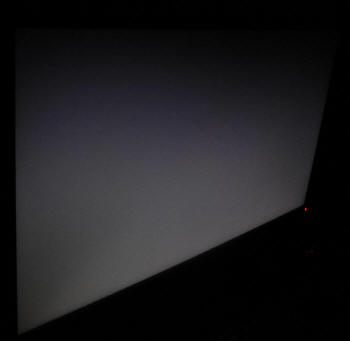
Above: View of an
all black screen from the side. Click for larger version
On a black image there is a characteristic white
glow when viewed from an angle, commonly referred to as "IPS-glow". This is
common on most modern IPS-type panels and can be distracting to some users. The
level of glow here is the same as other recent high refresh rate IPS panels
we've seen like the Acer XB270HU and Asus MG279Q (which use the same panel, so
not surprising) and is pretty typical of a modern IPS-type panel. If you view
dark content from a normal head-on viewing position, you can actually see this
glow slightly as your eyes look towards the edges of the screen. Some people may
find this problematic if they are working with a lot of dark content or solid
colour patterns. In normal day to day uses, office work, movies and games you
couldn't really notice this unless you were viewing darker content. If you move
your viewing position back, which is probably likely for movies and games, the
effect reduces as you do not have such an angle from your eye position to the
screen edges.
This is one area where the TN Film panel of some
other gaming displays is better, as there is
far less pale glow (Asus ROG Swift PG278Q example again) from an angle on
dark content. For dark room conditions, and a lot of dark content some people
might prefer to live with the more restrictive viewing angles and less glow of
the TN Film panel. Others might want to use the screen for more all-round uses
and prefer the IPS panel. It's down to preference really and your individual
uses.

Panel Uniformity
We wanted to test
here how uniform the brightness was across the screen, as well as identify any
leakage from the backlight in dark lighting conditions. Measurements of the luminance
were taken at 35 points across the panel on a pure
white background. The measurements for luminance were taken using BasICColor's calibration
software package, combined with an X-rite i1 Display Pro
colorimeter with a central point on the screen calibrated to 120 cd/m2. The below uniformity diagram shows the difference, as a percentage,
between the measurement recorded at each point on the screen, as compared with the
central reference point.
It is worth
noting that panel uniformity can vary from one screen to another, and can depend
on manufacturing lines, screen transport and other local factors. This is only a
guide of the uniformity of the sample screen we have for review.

Uniformity of Luminance

The luminance uniformity of the screen was
moderate overall with the corners showing
the most noticeable drop in luminance. In the bottom left hand corner for
instance the luminance dropped down to 94
cd/m2
minimum (-28%). Most of the central areas were within a reasonable 10%
deviance from the centrally calibrated point although overall only 31% of the
screen was within this 10% deviance. Nothing too bad here, although not
perfect. Being a gaming screen, the FS2735 is without Eizo's
DUE (Digital
Uniformity Equalizer) feature which is available on some of their high-end
models.

Backlight Leakage
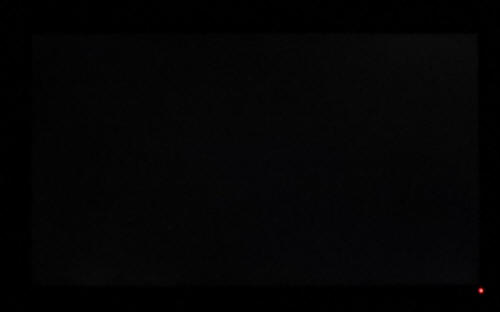
Above: All black screen in a darkened room. Click for larger version
As usual we also tested the screen with an all
black image and in a darkened room once the screen had been calibrated to a
sensible day to day
120 cd/m2.
A camera was used to capture the result from a distance of ~2m to limit any glow
which might be caused by viewing angles. The camera showed there was no real
clouding or bleeding at all on this sample which was excellent.

General and Office Applications
The FS2735 feature a large 2560 x 1440 WQHD
resolution, a significant step up from the wide range of 1920 x 1080 screens on
the market, especially when you compare it to the 27" gaming screens around with
only 1080p support. The pixel pitch of 0.233 mm is quite small as a result, and
by comparison a standard 16:10 format 24" model has a pixel pitch of 0.270mm and
a 30" model has 0.250mm. These ultra-high resolution 27" models offer a tight
pixel pitch and therefore small text as well. We found it quite a change
originally coming from 21.5 - 24" sized screens back in the day, even those
offering quite high resolutions and small pixel pitches. Although now we are
very used to working with 27" 1440p screens all the time and find them very
comfortable and a significant upgrade over 1080 / 1200p models. Some users may
find the small text a little too small to read comfortably, and we'd advise
caution if you are coming from a 19" or 22" screen for instance where the pixel
pitch and text are much larger. The extra screen size takes some getting used to
over a few days as there really is a lot of room to work with but once you do,
it's excellent. For those wanting a high resolution for CAD, design, photo work
etc, this is a really good option. The image was very sharp and crisp and text
was very clear.
With its
WQHD display, you enjoy 77% more desktop space than a full HD screen to spread
out your windows and palettes.
The very
thin bezel design mean that the screen could be easily integrated into a
multi-screen set up if you wanted. The light AG coating of the modern
AHVA (IPS-type) panel is certainly welcome, and much better than the older
grainy and 'dirty' appearance of older IPS AG coatings. It is also less grainy
than the TN Film coating in popular gaming models based on that technology. The
wide viewing
angles provided by this panel technology on both horizontal and vertical planes,
helps minimize on-screen colour shift when viewed from different angles and as
we've already covered this is a significant improvement over TN Film panels.
The default setup of the screen
was good, offering a decent gamma curve, reasonable white point, strong
contrast ratio and very low dE. Correcting the white point is easy through a
couple of RGB changes in the menu, and even without calibration we thought the
image looked decent for day to day office work.
The brightness range of the
screen was excellent, with the ability to offer a luminance between 331 and an
incredibly low 1 cd/m2. This should mean the screen is perfectly useable in a wide
variety of ambient light conditions, including darkened rooms. A setting of ~71
in the OSD brightness control should return you a luminance close to 120 cd/m2
out of the box. On another positive note, the brightness regulation is
controlled without the need for the use of the now infamous
Pulse-Width Modulation (PWM), and so those who suffer from eye fatigue or
headaches associated with flickering backlights need not worry. It's a hybrid DC
method, with a very low amplitude/high frequency oscillation introduced at low
brightness settings below 55%. Although you would want to be working with a
luminance of <50 cd/m2 for that range of brightness control to even
be used, so for most users you will never enter the "oscillation zone" anyway
and you can forget about it.
There was a very
slight audible buzzing from the screen, but only if you listened very closely to
it. Certainly nothing you could detect in normal use from a normal distance. The
screen also remains cool even during prolonged use. There is a specific preset
mode for office work and reading which is the "paper" mode in the menu. This
delivered a more yellow and warmer image than our calibrated state which is
listed in the OSD menu as 4500k, and might be more comfortable for some of this
type of work. Note that there are not any specific blue light filter modes on this model. If you refer to the spectral output in the calibrated user1 mode
(6500k),
and the paper preset mode (both set to the same approximate luminance) you can
see that there is a reduction in the blue light output thanks to the warmer
setting though:
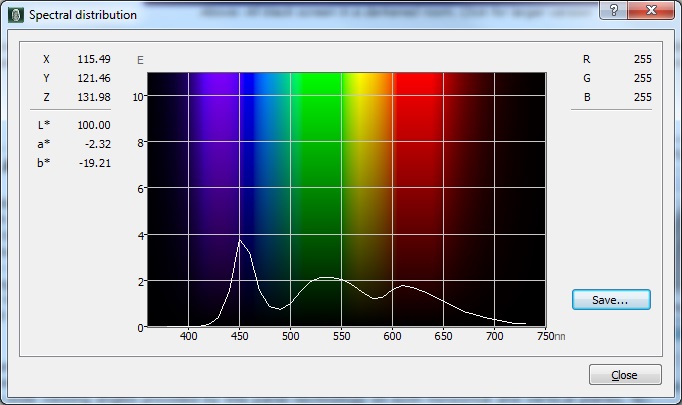
Spectral
distribution, calibrated user1 mode (6500k)
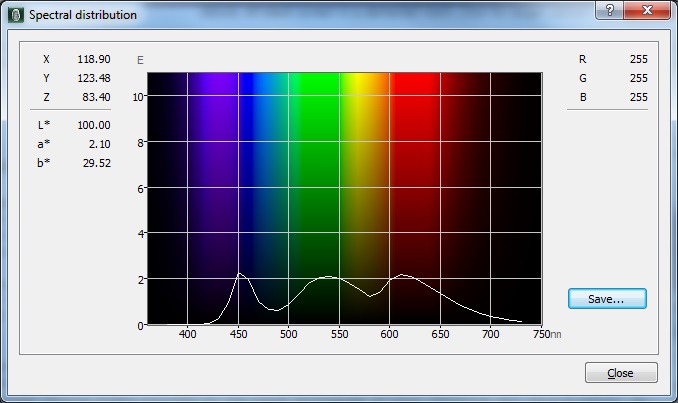
Spectral
distribution, paper preset mode (4500k)
The screen offers 2x USB 3.0 ports which can be
useful and it was nice to keep this up to date with the modern version, but both
are located on the back left hand side of the display for relatively
easy-access. Integrated speakers can provide sound for the odd YouTube clip or
mp3 if you want and there's also audio out/headphone ports. The EcoView ambient
light sensor can be really handy in office environments for changing the
brightness of your screen automatically depending on your ambient light
conditions. Nice to see that included here. There are no further extras like
card readers or motion sensors which can also be useful in office environments.
There was a decent range of ergonomic adjustments available from the stand
allowing you to obtain a comfortable position for a wide variety of angles. They
were mostly very stiff though so you might not want to move it around too often.
The VESA mounting support may also be useful to some people as well.

Above: photo of
text at 2560 x 1440 (top) and 1920 x 1080 (bottom)
The screen is designed to run at its native
resolution of 2560 x 1440 and at a 144Hz native refresh rate. However, if you
want you are able to run the screen outside of this resolution. We tested the
screen at a lower 1920 x 1080 resolution to see how the screen handles the
interpolation of the resolution, while maintaining the same aspect ratio of
16:9. At native resolution the text was very sharp and clear. When running at a
1080p resolution the text is still actually nice and clear, with low levels of
blurring. You do lose a lot of screen real-estate as well of course but the
image seems to be quite well interpolated if needed.

Gaming Introduction
The Foris FS2735 is aimed at a gaming audience
primarily. The screen offers you a 2560 x 1440 resolution AHVA (IPS-type) panel
with a high native 144Hz refresh rate, which until about a year ago was not offered in the market
at all. Now we've seen a
few 1440p high refresh IPS gaming screens emerge. The extra resolution compared with
1080p is certainly a welcome upgrade and the availability of high refresh rates
in a panel other than TN Film is very attractive. In this instance, the high
refresh panel has then been combined with AMD
FreeSync for the benefits of dynamic refresh rate control. This is
particularly important given the added resolution here, as the demands on your
system running games at 1440p @ 144Hz are very high.
FreeSync capable screens don't automatically carry any blur
reduction mode, unlike G-sync where the ULMB feature is integrated into the
added G-sync module. However, Eizo have opted to add a native blur reduction
system of their own to the
FS2735 which is great news for various reasons. It's actually the first IPS
screen with FreeSync support and a blur reduction mode for a start. We have
already tested the
Asus MG279Q which although it provided FreeSync and high refresh IPS, it did
not have any blur reduction modes available. On G-sync screens the ULMB (Ultra
Low Motion Blur) feature is also limited only to compatible G-sync graphics
cards, so you cannot use the feature with external devices connected or
non-NVIDIA systems (or old NVIDIA cards). Because Eizo have added this blur
reduction feature natively to the screen you can use it from any graphics card
system (NVIDIA included).
For those perhaps unfamiliar, this blur reduction
feature allows for a strobing backlight to
reduce perceived motion blur in dynamic content. Have a read of
our blur
reduction backlight article which talks about the benefits of these kind of
technologies in more detail. It's a feature some people really like when it
comes to dynamic content, primarily gaming. It can really help reduce the motion
blur you see on the screen due to the way LCD technology operates. As with other
screens which support any blur reduction feature, it unfortunately cannot be used at the same time as
FreeSync since
that operates with a dynamic refresh rate by its nature. You can enable blur
reduction if
you would rather use that to FreeSync when your screen is set to 60, 100, 120 or
144Hz refresh rates. We will look at the blur reduction operation
in more detail later.
|
2560 x 1440 Resolution |
 |
|
IPS-type panel technology |
 |
|
Max refresh rate support
|
144Hz |
|
FreeSync support |
 |
|
Blur Reduction mode
Blur Reduction supported modes |

60, 100,
120, 144Hz |

Response Times
|
Quoted G2G Response Time |
4ms G2G |
|
Quoted ISO Response Time |
n/a |
|
Panel Manufacturer and
Technology |
AU Optronics AHVA (IPS-type) |
|
Panel Part |
M270DAN02.3 |
|
Overdrive Used |
Yes |
|
Overdrive Control Available to
User |
Overdrive |
|
Overdrive Settings |
Off, Standard, Enhanced |
The FS2735 is rated by Eizo as having a 4ms G2G response time, which indicates the panel uses
overdrive /
response time compensation (RTC) technology to boost pixel transitions
across grey to grey changes. There is user control over the overdrive impulse
within the OSD menu using the 'Overdrive' option. The
part
being used is the
AU Optronics M270DAN02.3 AHVA (IPS-type) panel. Have a read about response time in
our
specs section if you need additional information about this measurement.
We will first test the screen using our thorough
response time testing method. This uses an oscilloscope and photosensor to
measure the pixel response times across a series of different transitions, in
the full range from 0 (black) to 255 (white). This will give us a realistic view
of how the monitor performs in real life, as opposed to being reliant only on a
manufacturers spec. We can work out the response times for changing between many
different shades, calculate the maximum, minimum and average grey
to grey (G2G) response times, and provide an evaluation of any overshoot present
on the monitor.
We use an
ETC M526
oscilloscope for these measurements along with a custom photosensor device.
Have a read of
our response time measurement article for a full explanation of the testing methodology and reported
data.
Response Time Setting Comparison

The FS2735 comes with a user control for the
overdrive impulse available within the OSD menu in the 'advanced settings' section
of the 'color' menu. There are
3 options available here under the
'overdrive' setting. First of all we carried out a fairly small set
of measurements and motion tests in all three settings for the
purposes of identifying which was the optimum response time setting. There tests
were conducted at a range of refresh rates from 60 to 144Hz as sometimes that
can have an impact on the overdrive control and resulting response times.
Overdrive Off

With the overdrive set to 'off' there was no
overdrive impulse being applied to the panel. As a result, overall the response
times were fairly slow at 12ms G2G average. There were a few transitions which
were slower up to around 20ms (changes from black to grey). Since there was no
overdrive being applied there was no overshoot at all of course. We have seen
response times vary with differing refresh rates before where the overdrive
impulse is influenced by the refresh rate. Since there was no overdrive impulse
being used in this mode, it made no difference.
Overdrive Standard



With the overdrive setting now at the middle
'standard' mode, there had been some improvements to response times. Firstly if
we look at the response times at 60Hz, the average 8.6ms G2G with very little
overshoot introduced was about as good as you can expect from an IPS-type panel,
and in keeping with what we've seen from the better 60Hz IPS models on the
market. The screen showed an odd behaviour though when you increased the refresh
rate, and actually the response times are slower as you do so. From other high
refresh rate screens we've tested we were expecting the overdrive impulse to be
applied a little more aggressively as you increased the refresh rate, allowing
the pixels to be driven that little bit faster to cope with the increase in
frame rates. We've seen other similar high refresh rate IPS models reach down to
around 5ms G2G using this method.
As a reminder, you need response times to be
reliably and consistently under the rate at which a new frame is sent to
the screen to avoid added blurring and smearing. So at 60Hz refresh rate the
response times need to be < 16.67ms to avoid these problems for instance (60
frame per second, a new frame every 16.67ms). Obviously there is still a
difference between a 5ms G2G screen and a 16ms G2G screen at 60Hz, it's just
that if it were slower than 16.67ms on average it would add additional blurring
because the pixels could not keep up with the frame rate of the screen as well
as being slow transitions in the first place. At 100Hz the response times need
to be < 10ms, at 120Hz they need to be < 8.33ms and at 144Hz they need to be <
6.94ms.
On the FS2735 the response times actually get
slower as you increase the refresh rate as the overdrive impulse is reduced.
100Hz can just about handle the frame rate, but even then a lot of the
transitions are pushing it a lot, and some are slower than the 10ms requirement.
Anything higher than 100Hz certainly adds visible additional smearing since the
response times are not sufficient really to cope with the frame rate. Eizo tell
us that they do not want to introduce a lot of overshoot in the 'standard' mode
which is why the overdrive impulse behaves in this way. We have to say it is a
little odd as we've seen other similar screens like the
Acer Predator XB270HU and
Asus ROG Swift PG279Q handle the increased refresh rate very well,
increasing the overdrive impulse and improving the response times as you
increase the refresh rate - all without introducing excessive overshoot
problems.
The crux of this is that if you're using the
FS2735 for external devices, consoles etc and want to run at 60Hz then the
'standard' mode is sufficient (and optimum when you consider the 'enhanced' mode
at 60Hz in the following section). If you are using the 'FreeSync (Low)' range
of 30 - 90Hz (talked about in the
following
sections) then it's also mostly sufficient to handle those refresh rates
without introducing additional blurring problems. Anything above 90 - 100Hz
including the higher Blur Reduction modes and the higher end of the 'FreeSync
(High)' range of 56 - 144Hz will struggle, as the response times aren't fast
enough to handle the frame rate demands and additional blurring and smearing is
introduced. That leaves us with the 'Enhanced' mode instead which we will test
now...
Overdrive Enhanced



With overdrive now pushed up to the maximum
'enhanced' mode you can see massive amounts of overshoot at 60Hz refresh rate.
Response times have been driven down lower to 6.6ms G2G average but the
overshoot is obvious and distracting in practice. As you push the refresh rate
up, the overdrive impulse is again toned down a little each time. At 100Hz there
is still fairly high levels of overshoot but it's not as bad as at 60Hz
certainly. At 144Hz the overshoot has completely disappeared and response times
are still very good at 6.8ms G2G.
So if you are running at 120Hz or 144Hz fixed
refresh rates, the 'enhanced' mode is sufficient to cope with the high frame
rates, with response times low enough, and with low to non-existent overshoot
also. That's good news, and so if you're using the
Blur Reduction
mode at these higher refresh rates (which is a better option than at 60Hz and
100Hz) then the 'enhanced' overdrive mode is optimal. There's one issue though
in that if you want to use 'FreeSync (High)' mode, that operates between 56 and
144Hz refresh rates dynamically. At the higher end the enhanced setting returns
fast response times and little/no overshoot, but if your refresh rate drops down
below ~100Hz, and particularly as you reach near to the lower end of the range,
this overdrive mode introduces a lot of excessive overshoot which will be
distracting. You can't use the 'standard' overdrive mode really as at the upper
refresh rate end it isn't fast enough, so you're stuck somewhere between the
two.
This is a bit of a shame, as the FreeSync High
mode doesn't really have a suitable overdrive mode to pair it with for its full
range. It's not the end of the World though as we expect the 'enhanced' mode is
the better option for most users as if you're using the FreeSync High setting
you will hopefully have a powerful system and be pushing the upper end of the
refresh rates from 100 - 144Hz anyway. If you are, then the overshoot doesn't
really cause a problem and response times are fast. If you have a lower system
spec and find you are achieving more in the 56 - 100Hz range (when using
FreeSync High) then you'd be better switching to the 'standard' overdrive mode
and may also want to consider the FreeSync Low (30 - 90Hz) range instead.
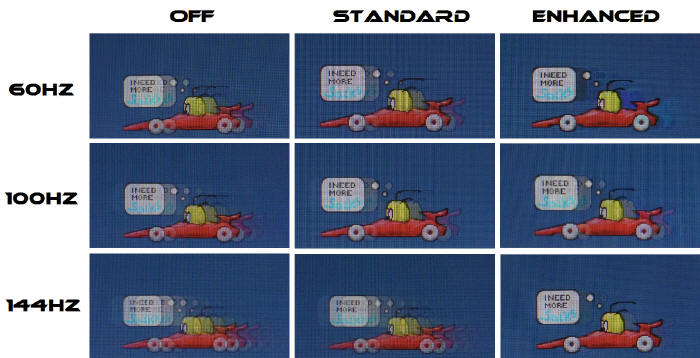
Click for larger
version
We will try to demonstrate what we've measured
above here in another way, to give an idea of what you can see in practice
running some simple motion tests. We used the familiar PixPerAn tool, testing
the screen in each of the overdrive settings and at a selection of refresh rates
from 60Hz all the way up to 144Hz.
With overdrive set to 'off' first of all you can
see some noticeable motion blur at 60Hz as you might expect from the 12ms G2G
average response times we measured. As you increase the refresh rate, the
blurring and smearing gets worse. This isn't a result of slower response times,
as actually we measured the same response times in each refresh rate mode when
overdrive was set to 'off'. Instead, it is a result of the mis-match between
response times and frame rate, with the pixel transitions not being fast enough
to keep up with the changing frames on the screen. The result is excessive
smearing as you increase the refresh rate. The overdrive 'off' mode can probably
be ignored for most people.
With overdrive then turned up to the middle
'standard' mode you can see an improvement in motion clarity and reduction in
blur at 60Hz, compared with overdrive 'off'. At 100Hz the blur is pretty
similar, although you do sometimes see a little extra smearing in places as the
response times are a bit slower, and the frame rate demands are getting too fast
for the pixel transitions. You get some added perceived motion clarity because
of the higher refresh rate, but you start to get some slight additional smearing
because of the slower response times. Above 100Hz, the smearing becomes more
noticeable as, like the overdrive 'off' mode, the response times can't keep up
with the frame rate.
Finally with the maximum overdrive 'enhanced' mode
you can see some overshoot at 60Hz, shown here with some dark trailing behind
the speech bubble and yellow head. This is quite obvious in practice as well. At
100Hz most of that overshoot has gone in these particular tests, but we know
from our oscilloscope measurements that some transitions still show some high
levels of overshoot. By the time you reach 144Hz though the overshoot has all
gone and pixel response times are thankfully fast enough for the frame rate. As
we've said already, the enhanced mode is certainly best for refresh rates >
100Hz and definitely when you start pushing towards 144Hz maximum. For refresh
rates < 100Hz the standard mode is probably better due to the absence of
overshoot artefacts in those lower refresh rates.

More Detailed Measurements
Overdrive setting = Enhanced, 144Hz Refresh Rate
Having established that the 'enhanced' setting
offered the best response/overshoot balance at the maximum 144Hz refresh rate we
carried out our normal wider range of measurements as shown below.
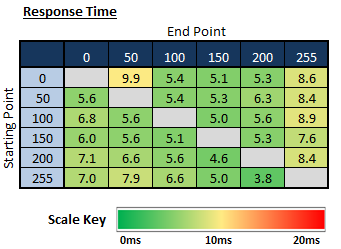
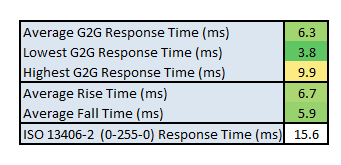
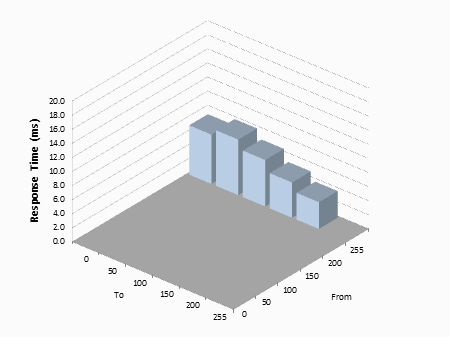
The average G2G response time was more accurately
measured at 6.3ms which was excellent for an IPS-type panel really.
Transitions were pretty stable across all the changes, whether they were changes
from dark to light (rise times) or from light to dark (fall times). The fall
times were a little faster. Some transitions did reach down to around the specified
4ms G2G as well although only in a couple of cases.
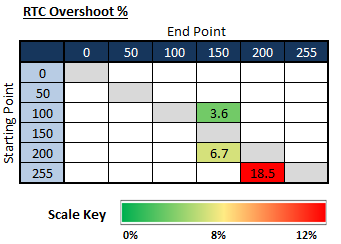
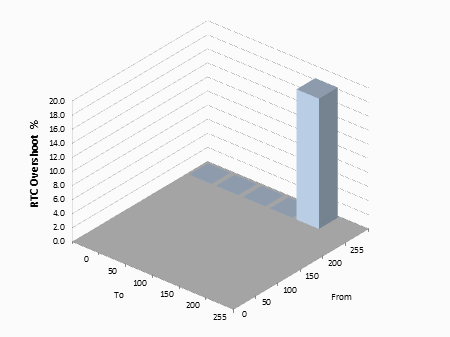
If you stick to 144Hz refresh rate this enhanced
overdrive setting shows very little overshoot at all which was pleasing. We know
that as you lower the refresh rate though, this setting results in some much
higher overshoot. If you're dropping below about 100Hz refresh rate we would
recommend switching to the 'standard' overdrive mode as we
talked
about earlier.

Display Comparisons
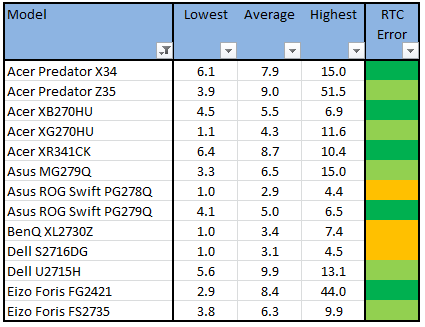
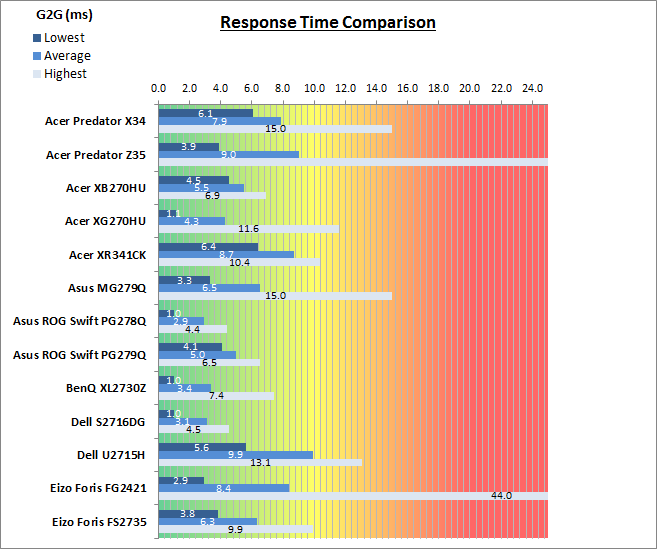
The above comparison table and graph shows you the
lowest, average and highest G2G response time measurement for each screen we
have tested with our oscilloscope system. There is also a colour coded mark next
to each screen in the table to indicate the RTC overshoot error, as the response
time figure alone doesn't tell the whole story.
Overall the responsiveness of the FS2735 was
fairly similar to the other high refresh rate IPS panels we've tested when you
compare their optimal response time setting and at their highest 144Hz refresh
rate. The high refresh rate IPS screens do behave differently though and it's
interesting to compare them a little further here.
Firstly there's the two G-sync enabled screens,
the
Acer Predator XB270HU and
Asus ROG Swift PG279Q. These were marginally faster overall at 5.5 - 5ms G2G
respectively when at their optimal response time settings and 144Hz refresh
rate, making them a little faster than the FS2735 (6.3ms G2G). They were also
free of any real overshoot at all, whereas the Eizo showed a couple of
transitions with a bit of overshoot (not much though). The G-sync module on
those two models successfully controlled the overdrive impulse to improve
response times as refresh rate increased, without introducing any overshoot
side-effects. That dynamic control of the overdrive impulse worked really well
from the G-sync screens and in our opinion, that's how it should work. You can
stick with the one optimal response time setting and the full refresh rate range
can be achieved without any response time issues.
As we've seen, the Eizo FS2735 behaves a bit
differently. Being a FreeSync screen it doesn't have a G-sync module obviously,
and the overdrive circuit built in to the screen needs to be able to handle the
changing refresh rates when using the FreeSync. This isn't ideal on the FS2735
as when the refresh rate increases, the overdrive impulse is turned down. That's
to avoid overshoot problems according to Eizo, but it results in slower response
times and does make it a bit tricky to find a suitable overdrive setting if you
use FreeSync. Not impossible, as it really depends on your system and thankfully
there's a fairly simple cut off point where it makes sense to use the standard
or enhanced mode. If we think back to when the first FreeSync screens were
released, they all had a bug where the overdrive control didn't work at all from
FreeSync systems, so it's obviously quite hard to get the overdrive circuit and
response times working effectively on the FreeSync setup. Add to that the
complications of having to stipulate operating ranges and it feels like FreeSync
still has a few more teething problems than G-sync.
The fast gaming TN Film based models like the
Asus ROG Swift PG278Q and
BenQ XL2730Z are a bit faster and snappier than the IPS screens and so some
people prefer them for gaming still. Some users prefer the "feel" of the TN Film
panels and their fluidity, and combined with a 144Hz refresh rate and G-sync you
have a lovely, smooth gaming experience.
The screen was also tested using the chase test in
PixPerAn for the following display comparisons. As a reminder, a series of
pictures are taken on the highest shutter speed and compared, with the best case
example shown on the left, and worst case example on the right. This should only
be used as a rough guide to comparative responsiveness but is handy for a
comparison between different screens and technologies as well as a means to
compare those screens we tested before the introduction of our oscilloscope
method.

27"
4ms
G2G AU Optronics AHVA (IPS-type) @ 144Hz (overdrive = enhanced)
In practice the Foris FS2735 performed best with
the response time setting at enhanced and refresh rate at 144HZ maximum. There were low levels of blurring evident, the image looked sharp
and there was no overshoot detected in these tests at all. The higher refresh
rates up to 144Hz provided additional levels of motion clarity and image
smoothness which surpassed what was possible from 60Hz panels. The additional
FreeSync support for AMD users will also be of real benefit.

27"
4ms
G2G AU Optronics AHVA (IPS-type) @ 144Hz (overdrive = enhanced)

27"
4ms
G2G AU Optronics AHVA (IPS-type) @ 144Hz (OD = Normal)

27"
4ms G2G AU Optronics AHVA (IPS-type)
@ 144Hz (OD = Normal)

27"
4ms
G2G AU Optronics AHVA (IPS-type) @ 144Hz (Trace Free = 80)
The above images compare the FS2735 then with the
three high refresh rate IPS-type panels we've tested. In practice at these
settings they were all very similar really and it would be hard to separate them
all. The PG279Q and XB270HU are a little faster.

27"
4ms
G2G AU Optronics AHVA (IPS-type) @ 144Hz (overdrive = enhanced)

27"
1ms
G2G AU Optronics TN Film @ 144Hz (Response Time = Normal)

27"
1ms
G2G AU Optronics TN Film @ 144Hz (OD = Normal)

27"
1ms
G2G AU Optronics TN Film @ 144Hz (AMA = High)

27"
1ms
G2G AU Optronics TN Film @ 144Hz (OD = Normal)
The above then compares the FS2735 with a few
popular TN Film based gaming models, all with 2560 x 1440 resolution and 144Hz
refresh rate. In practice the IPS models show smooth and fluid movement and are
also free of any noticeable overshoot which is pleasing. The TN Film models are
slightly faster, and have a slightly different "feel" than the IPS models, but
most users would be perfectly happy with any of the options here for gaming.

FreeSync
We won't go in to all the details about FreeSync
operation or how it improves gaming experience. You can have a read of
our article about dynamic refresh rates if you want more information, or
there's plenty of information online about FreeSync as well from a graphics card
point of view. We did want to briefly touch on the FreeSync range available from
the FS2735 though. At the moment Eizo tell us there is a limit with FreeSync operation range
which means it can only function within approximately 2.5 times the lowest
refresh rate. By default the FS2735 therefore offers an operational range
between 56 and 144Hz which makes full use of the upper refresh rate range of the
panel. If you have a lower powered system, or would benefit more from FreeSync
being able to control things at the lower end more, Eizo have enabled a second
operational mode which is 30 - 90Hz. So as a user you can choose which range you
want to use FreeSync in which is useful.
You can control this via an administrator menu
which is available by holding up on the joystick while the screen is powered
off, then holding the power button for about 2 seconds to bring the screen back
on (still holding the joystick up). A new menu automatically appears allowing
you to switch between the FreeSync (High) and FreeSync (Low) ranges:
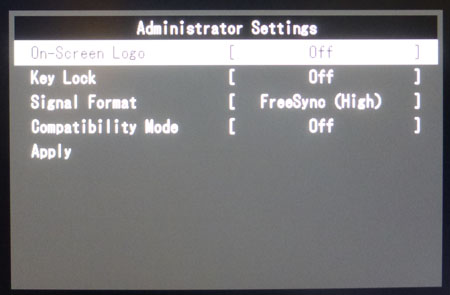
You will also want to think about which overdrive
mode you run the screen at depending on your refresh rate and which FreeSync
range you use. See our
earlier
response time tests for more information.

Blur Reduction
The Eizo Foris FS2735 also features an integrated
Blur Reduction Backlight system which is built in to the monitor and can be used
from any graphics card vendor. We have
already seen a lot of positive improvements in perceived motion blur from such
systems in the past. Our
in depth article from June 2013
(updated 17 March 2015) looked at this in a lot
more detail, and tested some of the original LightBoost "hacks" to achieve a
strobed backlight and blur reduction benefits. Since then we've seen a quite a
lot of
monitors integrate a strobed backlight with simple user control from the
menu and with better implementation than LightBoost methods. Unlike G-sync
screens where the ULMB feature is built in to the G-sync module, and can
therefore only be used when connected to compatible NVIDIA cards, this function
is integrated into the monitor directly and so does not carry those kind of
limitations.

On the FS2735 the feature is available when running the
screen at 60, 100, 120 and 144Hz refresh rate modes. It's actually therefore the
first high refresh rate IPS panel where we've seen blur reduction available at
144Hz, with 120Hz being the previous upper limit for other competing screens.
The blur reduction does not have any further settings available to it once
enabled, as some screens have a "pulse width" setting which allows you to
control the length of the strobe and therefore control the perceived blurring
even more (although at the cost of brightness).
A Bug When Enabling Blur Reduction on
FreeSync Systems

Of interesting note is that when we had the screen
connected to our AMD system (with Club Radeon R9 290 series graphics card) we
had some issues enabling the blur reduction mode. This is related to the
activation of the FreeSync feature, which cannot be used at the same time as
blur reduction. There seems to be a bug with the AMD drivers (from what Eizo
tell us) whereby the screen always thinks that FreeSync is enabled, even if you
have not selected it in the AMD control panel. We installed the latest AMD
drivers and ensured FreeSync was turned off in the control panel as shown above.
However, you can tell by the power LED on the screen that it thinks FreeSync is
still enabled as the power LED glows red (it would be white if FreeSync was not
detected). This results in the blur reduction option being greyed out in the OSD
menu annoyingly. If you change the refresh rate in Windows to 60Hz then the
screen assumes FreeSync is off and the power LED goes white again, allowing you
to turn blur reduction on.
This is a bit of an annoying bug, but Eizo tell us
it is related to the AMD drivers and FreeSync detection. Fortunately there's a
fairly easy way around this via the admin OSD menu.
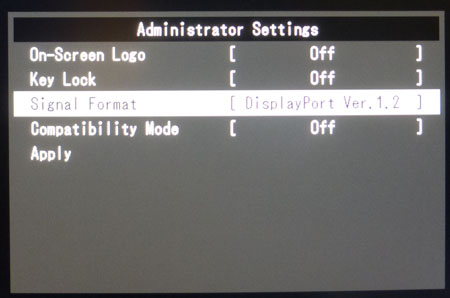
If you go in to the admin menu (power screen off,
hold up on joystick then hold power button for 2 seconds while it powers back
on) then you can turn off FreeSync completely. Just change to the DisplayPort
Ver 1.2 mode as shown above. You can then happily select all refresh rates in
Windows (60, 100, 120, 144Hz) and blur reduction can be enabled from there.
Note, use DP v1.2 as v1.1 only allows you to choose up to 60Hz max refresh rate.
If you are running in FreeSync (low) mode then blur reduction will be available
in the menu if you are set to any fixed refresh rate above the 90Hz FreeSync
range. So actually you could have the screen set to operate in 30 - 90Hz
FreeSync range, but still use blur reduction at 120 or 144Hz without any issue
in the menu.
Hopefully at some point this bug with the AMD
drivers will be fixed and you won't have to bother with this step. Obviously if
you're using the screen from a non-FreeSync card or NVIDIA system you don't have
to worry about it.
Operation - 60Hz
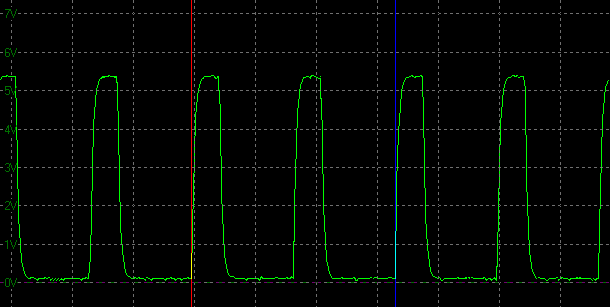
Blur
Reduction
backlight cycling, 60Hz
(scale = 5ms)
We measured the screen using our oscilloscope when
viewing a solid white image, with the blur reduction feature turned on and with
refresh rate set at 60Hz. This is the lowest refresh rate at which you can
operate at. Normally the oscillograph would show a flat straight
line when measuring a static white image (as no PWM is being used for backlight
dimming), but here the blur reduction feature is cycling the backlight off and
on rapidly.
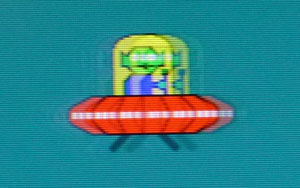
Pursuit camera photo showing doubling of image due to double strobe
At 60Hz, a single strobe per frame would be done
every 16.677ms but actually that frequency is too low and would produce visible
and noticeable flicker. Instead, on the FS2735 the strobing is doubled when
running at 60Hz refresh rate, so the backlight is strobed twice per frame, at
the equivalent of 120Hz. You can see from the oscillograph above therefore that
each frame of 16.67ms contains two full strobes. Unfortunately in practice this
double strobing produces visible doubling of the image as the above pursuit
camera photo shows. As a result, we don't believe the 60Hz blur reduction mode
is practical as it just creates problems with the image.
Operation - 100Hz
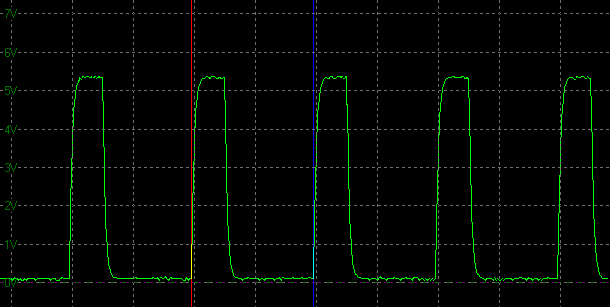
Blur
Reduction
backlight cycling, 100Hz
(scale = 5ms)
When running the screen at a 100Hz refresh rate
the behaviour is more what we are used to. The strobe is now
synced with the new refresh rate, with a new strobe every 10ms (100 times per
second).

Pursuit camera photo at 100Hz
With the strobe now properly synched with the
refresh rate, the blur reduction feature behaves as it should, with a much
clearer image than at 60Hz. If you're using blur reduction at 100Hz we would
recommend the 'standard' overdrive mode
as
explained earlier.
Operation - 120Hz
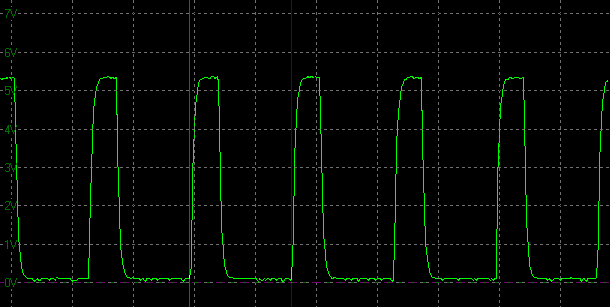
Blur Reduction
backlight cycling, 120Hz
(scale = 5ms)
Again when running the screen at a 120Hz refresh
rate the strobe is synced with the new refresh rate, with a new strobe every
8.33ms (120 times per
second). The moving image gets slightly clearer with a little less trailing than
at 100Hz due to the higher refresh rate and more frequent strobes. If you're
using blur reduction at 120Hz we would recommend the 'enhanced' overdrive mode
as
explained earlier.

Pursuit camera photo at 120Hz
Operation - 144Hz
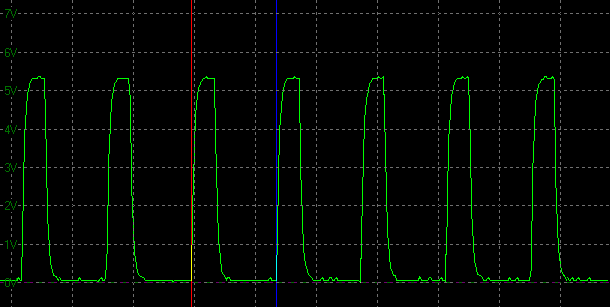
Blur Reduction
backlight cycling, 144Hz
(scale = 5ms)
Again when running the screen at a 144Hz refresh
rate the strobe is synced with the new refresh rate, with a new strobe every
6.94ms (144 times per
second). The moving image gets slightly clearer with a little less trailing
again than at 100 and 120Hz due to the higher refresh rate and more frequent
strobes. If you're using blur reduction at 144Hz we would recommend the
'enhanced' overdrive mode
as
explained earlier.
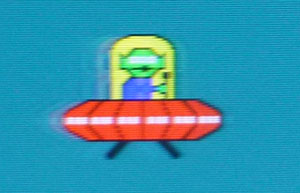
Pursuit camera photo at 144Hz
Brightness Range (144Hz)
|
Brightness Setting |
Luminance
(cd/m2) |
Black
Point (cd/m2) |
Contrast
Ratio
( x:1) |
|
100 |
179.95 |
0.19 |
947 |
|
75 |
102.08 |
0.11 |
928 |
|
50 |
61.59 |
0.07 |
880 |
|
25 |
32.14 |
0.04 |
804 |
|
0 |
14.89 |
<0.02 |
- |
We also wanted to test the brightness range of the
screen with blur reduction enabled, and the above confirms the range available through
the brightness OSD control.
You can achieve a slightly brighter display if you use the feature at 100 or 120Hz since the strobes are less frequent, but it's not a significant amount.
The upper brightness limit is actually pretty good here at 180
cd/m2, being
quite a lot higher than the NVIDIA ULMB screens we've tested which seem to max
out at around 123 cd/m2 so far as the upper brightness limit. So on
the FS2735 you can get to a higher brightness when using this feature which is
nice.
Maximum Blur Reduction Brightness - Display
Comparison
For ease of reference we have
also provided a comparison table below of all the blur reduction enabled
displays we've tested, showing their maximum luminance before blur reduction is
turned on (normal mode) and their maximum luminance with the feature enabled.
This will give you an idea of the maximum brightness you can expect from each
model when using their blur reduction feature, if that is important to you. A
lot of people want a brighter display for gaming and sometimes the relatively
low maximum luminance from blur reduction modes is a limitation.
These comparisons are with the refresh rate as
high as is available for the blur reduction feature to function. For most this
is at 120Hz, but some also support the feature at higher. You can achieve a
slightly brighter display if you use the feature at lower compatible refresh
rates since the
strobes are less frequent, but it's not a significant amount. That can also
introduce more visible flicker in some situations.
|
Model |
Refresh Rate |
Max Normal Luminance
Blur Reduction Off
(cd/m2) |
Max Luminance
Blur Reduction On
(cd/m2) |
|
Acer XB270HU* |
100Hz* |
327 |
111 |
|
Acer Predator Z35 |
120Hz |
359 |
111 |
|
Asus ROG Swift PG278Q |
120Hz |
385 |
123 |
|
Asus ROG Swift PG279Q |
120Hz |
331 |
101 |
|
BenQ XL2720Z |
144Hz |
282 |
119 |
|
BenQ XL2730Z |
120Hz |
309 |
191 |
|
Dell S2716DG |
120Hz |
328 |
118 |
|
Eizo FG2421 |
120Hz |
386 |
257 |
|
Eizo FS2735 |
144Hz |
331 |
180 |
Note:
Pulse Width setting at max where applicable.
*Note 2: The Acer XB270HU was later updated to include a 120Hz mode, which will produce a
slightly darker maximum luminance
Blur Reduction Tests
Of course the main thing we want to test is what
improvements the Blur Reduction mode offers when it comes to motion clarity and
gaming. We were pleased with the results we'd seen from LightBoost backlights
when we tested them, and also from the natively supported blur reduction
feature on other displays including the other popular TN Film gaming models
we've tested.
We were very pleased with the results
here as we had been on other blur reduction displays, with an obvious and marked improvement in perceived motion blur experienced
as long as you use the feature at 100, 120 or 144Hz refresh rate. At 60Hz the
double strobing introduced a doubling of the image which looked bad and so usage
in that mode should probably be avoided. At the other refresh rate settings tracking of moving objects became much easier and the image looked sharper and
clearer. The results got a little bit better each time you increased the refresh
rate due to the more frequent strobing, helping to cut out a little more of any
trailing you could see.
We used the BlurBusters full-screen
TestUFO online motion test (all blur reduction supported refresh rates) as well to put the
feature through its paces and were pleased with the results. The middle region
of the screen was the clearest with some strobe cross-talk becoming evident as
you reached the top and bottom. Eizo seemed to have got the strobe timing at a
nice level to maximise performance in the central region though which was good,
as that's where most of your focus is in games. It is impossible to eliminate
strobe cross-talk completely due to the way they operate, but the important
thing is whereabouts on the screen this manifests itself and to what level. The
central region is probably the most important since that's where a lot of your
gaming focus will be, where crosshairs and the likes are. This was another very good implementation of a strobe backlight
system here, and we were impressed even more so because it's a feature of the
monitor itself and so can be used no matter what your graphics card choice is.
Obviously in an ideal World you could use it with FreeSync as well, but that
will take some doing from the manufacturers to get working. A single strobe
feature for 60Hz operation might have been handy for some users too, although
the likelihood of visible flicker is then a problem.

Additional Gaming Features
Preset modes
- There are 6 user modes on the FS2735 which you can configure how you
like, along with one already pre-configured for gaming. So there really are
a lot to choose from if you want different set ups for different gaming
uses. Nice work from Eizo here.
Aspect
Ratio Control - The FS2735 has three aspect ratio control options in
the 'signal' section of the OSD, with settings for full screen, aspect ratio
and dot to dot (1:1 pixel mapping) available.
G-Ignition Software

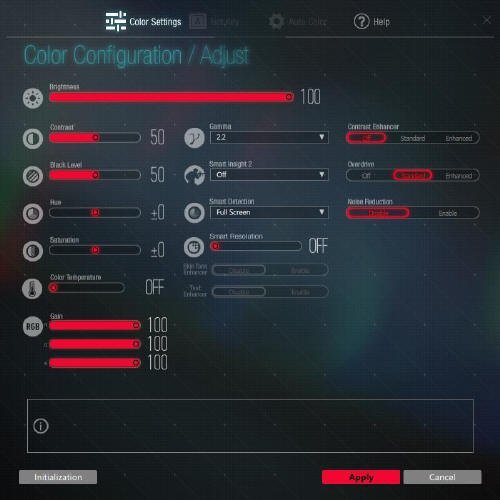
The Eizo material we were sent gives some useful information about this
software:
"G-Ignition 3.0 is Windows software for adjusting your monitor’s settings
including brightness, contrast, black level, hue, saturation, colour
temperature, and gamma as well as turn Smart Insight
Demolition
on
and off. This is much faster and more intuitive than manipulating control
buttons on the monitor itself (although this option is also available.)
Moreover, you can assign hot keys to make adjusting your monitor even
simpler. This is especially convenient when you want to quickly change your
in-game settings. Once you have adjusted your monitor to your preferred
settings, you can export them to 'G-Ignition
Drive'
for sharing with
other gamers. G-Ignition 3.0 software is available at no charge on
http://gaming.eizo.com/g-ignition/.
It is also included in the CD-ROM that comes with the monitor. A USB
connection with your Windows PC is required to use this software.
FORIS monitor control software with EIZO's
own cloud service, G-Ignition Drive. With this software and
its cloud service, FORIS owners can adjust gaming presets (monitor settings)
and can store or import the gaming presets by game title. As well
as share them over the social networks. In addition, gaming presets from
EIZO-sponsored professional gaming team Ninjas in Pyjamas are available on
G-Ignition Drive."
We installed the software quickly and easily
and had a play round with it. It works well and provides you all the useful
settings in one place to make quick and easy changes. You can select which
preset mode you are adjusting as well and we liked this feature. Easier than
reaching around the back of the screen and navigating through the menu
layers.
G-Ignition Mobile for
Smartphone
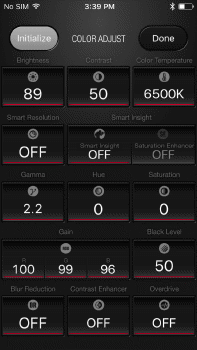
G-Ignition Mobile
is an iOS- and Android-compatible application that works with Bluetooth
Smart technology built into the FORIS FS2735. With this app, you can use your
smartphone to adjust
the monitor’s settings when the FORIS FS2735 is connected to any platform be
it Windows, Macintosh, or a console. You can also access G-Ignition Drive
and export your settings or import those from other gamers. It's basically
a phone version of the main software talked about above, and with your phone
linked to the screen via Bluetooth you can use the phone instead. Handy when
you are perhaps mid game and want to change something quickly without having
to exit out to the PC software.
On-Screen Notifications

In addition to adjusting your monitor’s settings, G-Ignition Mobile
keeps you updated with on-screen notifications. Most smartphone apps have
notifications. With G-Ignition Mobile, these notifications appear on
the FS2735 screen as icons.
G-Ignition Mobile provides five notification icons: Phone, E-mail,
Social, Game, and Information. You can assign whichever icon to your apps.
(Information is intended for any apps that do not correspond to any of the
other four icons.) You can manage your smartphone apps so only those whose
notifications you want to see will appear on screen. There are two ways to
use this feature. The first is straightforward – you will be notified
whenever you receive a phone call, text message, e-mail, or other
communication. Gamers who wear headphones no longer have to worry about
missing an important call or e-mail. Again quite a neat feature with your
phone paired to the screen.
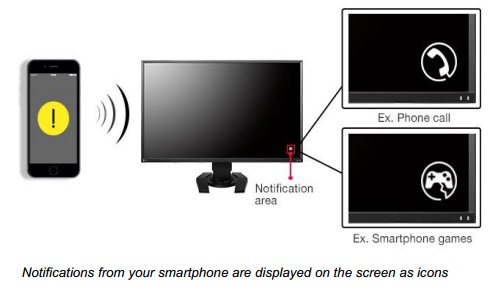
The second way is for those who also game on their smartphones. For example,
in a strategy game you may have to wait 20 minutes while you build a
fighting force of 100 soldiers. You can set your smartphone down and play
another game or do some other task on the FORIS FS2735. Once your soldiers
are ready, a notification will appear on the FS2735 and you can switch back
to your smartphone and commence with the battle.

Lag
We have written an in depth article about
input lag and the various measurement techniques which are used to evaluate
this aspect of a display. It's important to first of all understand the
different methods available and also what this lag means to you as an end-user.
Input Lag vs. Display Lag vs. Signal
Processing
To avoid confusion with different terminology we
will refer to this section of our reviews as just "lag" from now on, as there
are a few different aspects to consider, and different interpretations of the
term "input lag". We will consider the following points here as much as
possible. The overall "display lag" is the first, that being the delay between
the image being shown on the TFT display and that being shown on a CRT. This is
what many people will know as input lag and originally was the measure made to
explain why the image is a little behind when using a CRT. The older stopwatch
based methods were the common way to measure this in the past, but through
advanced studies have been shown to be quite inaccurate. As a result, more
advanced tools like SMTT provide a method to measure that delay between a TFT
and CRT while removing the inaccuracies of older stopwatch methods.
In reality that lag / delay is caused by a
combination of two things - the signal processing delay caused by the TFT
electronics / scaler, and the response time of the pixels themselves. Most
"input lag" measurements over the years have always been based on the overall
display lag (signal processing + response time) and indeed the SMTT tool is
based on this visual difference between a CRT and TFT and so measures the
overall display lag. In practice the signal processing is the element which
gives the feel of lag to the user, and the response time of course can
impact blurring, and overall image quality in moving scenes. As people become
more aware of lag as a possible issue, we are of course keen to try and
understand the split between the two as much as possible to give a complete
picture.
The signal processing element within that is quite
hard to identify without extremely high end equipment and very complicated
methods. In fact the studies by Thomas Thiemann which really kicked this whole
thing off were based on equipment worth >100,1000 Euro, requiring extremely high
bandwidths and very complicated methods to trigger the correct behaviour and
accurately measure the signal processing on its own. Other techniques which are
being used since are not conducted by Thomas (he is a freelance writer) or based
on this equipment or technique, and may also be subject to other errors or
inaccuracies based on our conversations with him since. It's very hard as a
result to produce a technique which will measure just the signal processing on
its own unfortunately. Many measurement techniques are also not explained and so
it is important to try and get a picture from various sources if possible to
make an informed judgement about a display overall.
For our tests we will continue to use the SMTT
tool to measure the overall "display lag". From there we can use our
oscilloscope system to measure the response time across a wide range of grey to
grey (G2G) transitions as recorded in our
response time
tests. Since SMTT will not include the full response time within its
measurements, after speaking with Thomas further about the situation we will
subtract half of the average G2G response time from the total display lag. This should allow us to give a good estimation of
how much of the overall lag is attributable to the signal processing element on
its own.
Lag Classification
To help in this section we will also introduce a broader classification system
for these results to help categorise each screen as one of the following levels:
-
Class 1)
Less than 16ms / 1 frame lag at 60Hz - should be fine for gamers, even at high levels
-
Class
2)
A lag of 16 -
32ms / One to two frames of lag at 60Hz - moderate lag but should be fine for many gamers.
Caution advised for serious gaming and FPS
-
Class
3)
A lag of more
than 32ms / more than 2 frames of lag at 60Hz - Some noticeable lag in daily usage, not
suitable for high end gaming
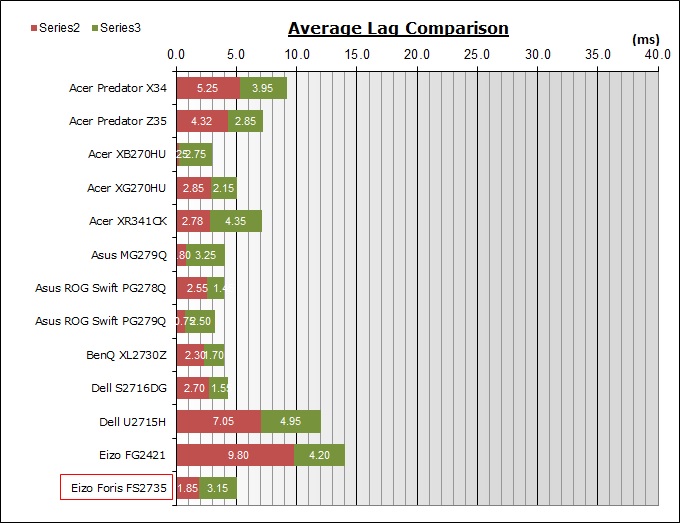
For the full reviews of the models compared here and the dates they were written
(and when screens were approximately released to the market), please see our
full
reviews index.
|
(Measurements in ms) |
|
|
Total Display Lag (SMTT
2) |
5.00 |
|
Pixel Response Time
Element |
3.15 |
|
Estimated Signal
Processing Lag |
1.85 |
|
Lag Classification |
1 |
|

Class 1 |
We have provided a comparison above against other
models we have tested to give an indication between screens. The screens
tested are split into two measurements which are
based on our overall display lag tests (using SMTT) and half the average G2G
response time, as measured by the oscilloscope. The response time is split from
the overall display lag and shown on the graph as the green bar. From there, the
signal processing (red bar) can be provided as a good estimation.
The screen showed a total lag of only 5.00ms.
Approximately 3.15ms of that can be accounted for by pixel response times,
leaving an estimated signal processing lag of only 1.85ms. This is basically
nothing and means the screen should be fine for all levels of gaming. This remains
pretty consistent at all refresh rates, and also when using blur reduction mode
also.

Movies and Video

The following summarises the screens performance
in video applications:
-
27"
screen size makes it a reasonable option for an all-in-one multimedia screen,
much smaller than LCD TV's and many larger format desktop monitors which are
now emerging.
-
16:9
aspect ratio is well suited to videos and movies, leaving
you with smaller/no borders on DVD's and wide screen content at the top and
bottom than on a 16:10 aspect display.
-
2560 x
1440 resolution can support full 1080 HD resolution content.
-
Digital DisplayPort interfaces support HDCP for any encrypted and protected content
-
DisplayPort and 2x HDMI connections available
for connecting external devices and Blu-ray players.
-
Cable provided in the box
for DisplayPort only.
-
Light
AG coating provides clear images with no major graininess, and without the
unwanted reflections of a glossy solution.
-
Wide
brightness range adjustment possible from the display, including high maximum
luminance of ~331
cd/m2 and an incredibly low minimum
luminance of only 1 cd/m2. This should afford you very good control for different
lighting conditions. Contrast ratio remains stable across the adjustment
range as well and is good for an IPS-type panel. Brightness regulation is controlled
without the need for PWM for much of the adjustment range and with only a low
amplitude/high frequency oscillation introduced at darker settings.
-
Black
depth and contrast ratio are good for an IPS-type panel at 990:1 after
calibration. Detail in darker scenes should not be lost as a result.
-
There
is a specific 'cinema' preset mode available which might be useful to set up
for movies and videos to your liking.
-
Good pixel responsiveness which can handle fast moving scenes in movies
without issue. If you're using an external blu-ray player at 60Hz, stick with
the 'standard' overdrive mode.
-
Although it has 120Hz+ refresh rate support it does not support NVIDIA 3D
Vision.
-
Wide viewing angles from IPS panel technology
meaning several people could view the screen at once comfortable and from a
whole host of different angles. White glow from an angle on black content may
be problematic to some users and is common for IPS panel technology.
-
No
real backlight leakage on our sample which is good.
-
Wide range of ergonomic adjustments available
from the stand, allowing you to adjust the screen to suit varying viewing
positions. However, these are very stiff to operate mostly so you may not want
to move it around much.
-
Basic
integrated stereo speakers offered on this model along with an audio out and
headphone connection.
-
Hardware aspect ratio options available for full screen, aspect ratio and 1:1
pixel mapping meaning it should handle external devices well.
-
Picture By Picture (PbP) or Picture In Picture (PiP) are not available on
this model.

Conclusion
If you enjoy the review and like our work, we
would welcome a
donation
to the site to help us continue to make quality and detailed reviews for you.
The FS2735 impressed us in many areas and it was
another very solid outing for high refresh rate IPS-type panels. These screens
offer great all round performance and overcomes many of the issues with TN Film
gaming screen, so it was pleasing to see another option on the market. Even more
so when it was from a vendor who aren't really a big player in the gaming market
but who are making an effort to offer something interesting and a little
different, with the backing of their brand and reputation behind them. It's
probably worth touching on the price of the screen to start with here as it's a
bit more expensive than other competing models, even those with the added
"G-sync tax" on top. The screen has not really been released yet although it
looks like you could find one for around £890 GBP on Google at the moment.
Popular alternatives like the Asus ROG Swift PG279Q (£750) and Acer Predator
XB270HU (£690) / XB271HU (£650) are a fair bit cheaper. The reason for the
additional cost here is down to some of the extras Eizo have included, and to
some extent the brand and support you get from them as a company.
We liked some of the extras provided here, and it
felt like there were lots of additional things to make this a premium gaming
screen. The PC and smartphone control software and Bluetooth integration were
interesting, and useful we felt. Eizo have included their EcoView ambient light
sensor which is handy for more general uses. You've got an additional cost on
top as well because they have added a native blur reduction mode. This should
not be underestimated in both performance benefits and function. Since it's
integrated in to the screen you can use it on all graphics card options, and
even at 144Hz refresh rate which is a first for IPS-type panels and blur
reduction modes. It's also the first IPS FreeSync screen released with a blur
reduction mode. There's a good range of ergonomic adjustments (although they are
stiff and a bit of a pain), good range of connectivity options, wide range of
configurable preset modes, and a nice simple design with sleek, slim bezels. So
a large part of what you're paying extra for is these features and the Eizo
brand.
Performance wise the IPS panel offered a good
default setup, excellent backlight adjustment control, PWM-free operation,
decent contract ratio and wide viewing angles. Gaming wise the response times
were fast and lag basically non-existent which was great. We've talked in depth
about some of the complications that FreeSync causes though, with the blur
reduction mode operation affected due to a bug. Also the response time control
is complicated and you have to be wary of the refresh rate you're operating at,
or want to operate at, when it comes to selected the best overdrive setting and
FreeSync range.
All in all it's a very good gaming screen and if
you are happy to pay a little bit more than some of the competition it has
plenty of extra features to keep you happy.
|
Pros |
Cons |
|
First high refresh rate IPS
screen with FreeSync and Blur Reduction offered |
Ergonomic adjustment stiff and
tricky to use |
|
Low lag, fast response times,
and interesting gaming extras provided |
FreeSync causes some bugs and
complications in Blur Reduction operation and overdrive control |
|
Solid all round performance
from IPS-type panel |
Glow on dark content is
remaining issue of IPS panels |